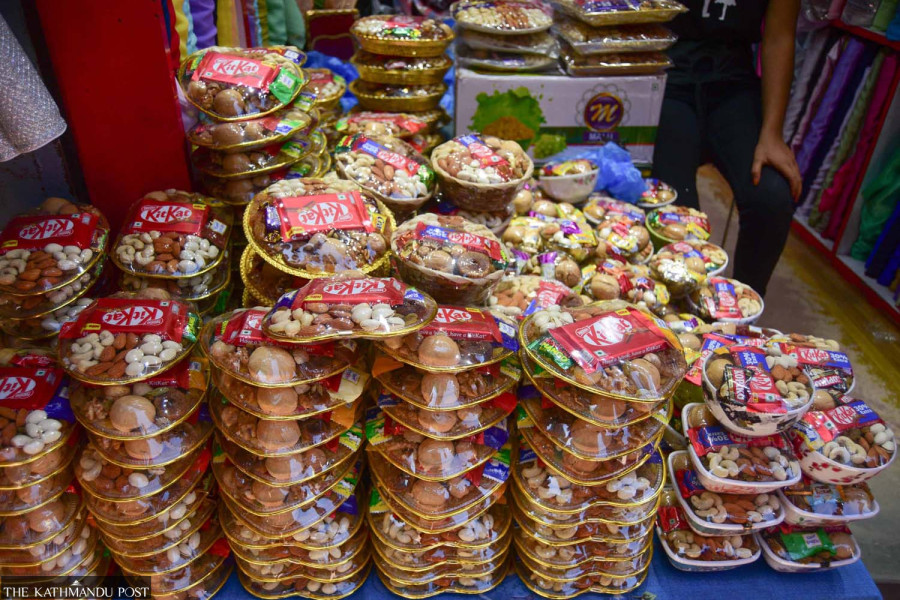Money
Tihar gifts become dearer as dry fruits prices skyrocket
Traders say prices of goods have increased due to heavy rainfall in late September that hit flower production and damaged roads, preventing imports.
Post Report
As Tihar, the festival of lights, begins on Wednesday, many expect it to be an expensive affair.
Everything has become costlier, from food items and flowers to gifts and lights.
During Tihar, sweets, dry fruits, footwear, watches, toys, home décor, and fashion clothing are the most sold items, which are gifted by sisters to their brothers as a token of love during Bhai Tika, which falls on November 3 this year.
Traders say that the prices of almost all goods have increased mainly due to heavy rainfall in late September that hit flower production and damaged roads, preventing imports.
Pabitra Bajracharya, president of Nepal Retailers Association, said that the prices of almost all dried fruits have gone up. “We do not know the exact reason, but the importers hiked the price. Tihar goods are costly.”
Some traders say they had to offset losses by increasing prices because transport costs rose heavily due to the damage to roads, mainly those connecting the Kathmandu valley.
Sisters gift packets of nutritious nuts, seeds, and other items to their brothers during the ceremonies, and sales soar during this time of the year.
According to the association, Tihar accounts for 40 percent of dry fruit sales. As demand increases fourfold during festivities, prices rise. This year, the road from the Chinese border in the north was severely affected, halting trade for a month.
The Rasuwagadhi border was opened on Tuesday after a month of closure. Customs officials say one-way traffic has resumed on the 24 km road stretch from Rasuwagadhi to Kerung in China, which was damaged by the late September floods.
Due to the road's closure, commercial goods worth millions of Nepali businessmen were stored in warehouses at the border and various cities in China for months.
Traders say rotting has damaged fruits and spices worth millions of rupees. Cargo coming to Kathmandu, the country’s commercial hub, from the southern border points was also affected, as the road connecting the Valley was severely affected by floods and landslides.
According to the association, the price of cashews has swelled from Rs1,600 per kg last year to Rs2,000 per kg. The price of almonds has jumped to Rs1,700 per kg from Rs1,300 per kg last year.
The price of walnuts has reached Rs650 per kg this festive season, up from Rs450 per kg a year ago. The price of pistachios remains unchanged at Rs2,100 per kg.
“Prices of other dried fruits like raisin, dates, coconut, green cardamom, cloves and betel nuts have also increased by Rs100 to Rs150 per kg,” said Bajracharya.
The dried fruits sold in the bazaars of Kathmandu are imported from diverse sources like Brazil, Afghanistan, Vietnam, the United States, Indonesia, Pakistan, Sri Lanka, Central America and the Middle East.
Similarly, according to florists, marigold flowers, one of the Tihar essentials, are set to become costlier this year.
Garlands—makhamali or marigold flowers strung together for the occasion—hold huge cultural significance during this festival, as sisters put them around their brothers' necks on a special day to honour their sacred bond.
“The late monsoon rains have caused loss to flower producers. Marigold flowers ready to be supplied to the market have been damaged by the insistent rains and flooding in many parts of the Kathmandu valley, including the neighbouring districts,” said Min Bahadur Tamang, president of Floriculture Association Nepal. “This will create a gap between demand and supply, increasing prices.”
He added, “We expect the price of metre-long marigold garlands to reach Rs125 this year compared to Rs100 during last year’s Tihar.” A metre-long garland contains 40 flowers.
Vibrant yellow marigolds and milky white chrysanthemums are necessary offerings to the goddess of wealth, Laxmi, during Tihar. Colourful blossoms are a major item during the festival, as people adorn the doors and windows of their houses with strings of flowers as part of the rituals.
“We expect transactions of Rs400 million from 4 million marigold garlands across the country and around 30,000 chrysanthemum (Godavari) garlands,” said Tamang.
According to the Floriculture Association Nepal, the globe amaranth (makhamali) is in demand for 500,000 garlands. This includes 150,000 garlands for export.
Tamang said that the Kathmandu Metropolitan City is seizing illegally imported flowers for Tihar in Kathmandu. Recently, the metropolis took control of marigold flowers from three cold stores in Balaju.
“Even today [Tuesday], a truck of flower garlands was impounded at Jaya Bageshwori in Kathmandu,” said Tamang.
Indian marigolds are not being legally imported this festive season as India’s agriculture ministry failed to issue a declaration letter.
Tamang said plant quarantine authorities in Nepal issue an import permit for marigold only after the Indian authority issues a declaration letter that the flower is free of 16 types of insect diseases.




 13.12°C Kathmandu
13.12°C Kathmandu













